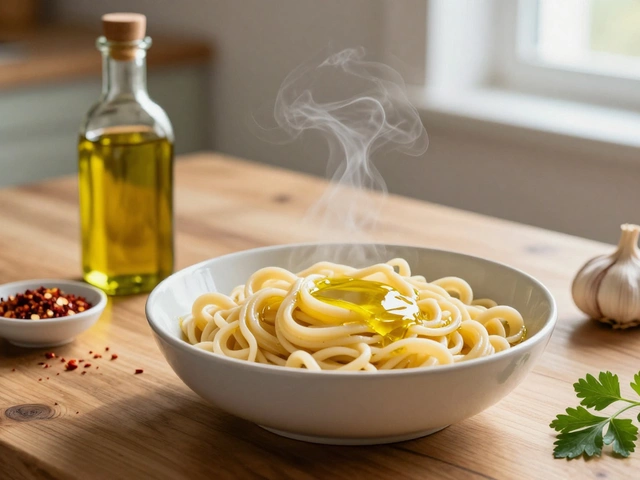Most people with diabetes have a sweet tooth—even if no one wants to admit it. Peanut butter sneaks its way into lots of desserts, raising big questions about whether it’s actually safe for blood sugar. Here’s a surprise: peanut butter is lower in carbs than most dessert ingredients, so in small amounts, it usually doesn’t cause blood sugar spikes like white bread or sugary cookies.
The magic numbers? Two tablespoons of regular peanut butter pack around 8 grams of protein, plenty of healthy fat, and only about 7 grams of carbs. That’s much less than your average slice of cake. Plus, those healthy fats and protein slow down the digestion of carbs, so you’re less likely to see a sudden surge in blood sugar. That means peanut butter can actually work as a smart swap for people craving a treat—but there’s a catch (there’s always a catch, right?).
- Why Peanut Butter Gets a Pass (Sometimes)
- Blood Sugar: What Really Happens
- Best Peanut Butter Choices for Diabetics
- Making Dessert Work for You
- Quick Peanut Butter Dessert Hacks
Why Peanut Butter Gets a Pass (Sometimes)
First off, peanut butter shows up in diabetes-friendly food lists way more often than you'd expect. That’s because it’s packed with healthy fats and protein but doesn’t pile on a lot of carbs. For folks managing blood sugar, this mix slows down how quickly sugar gets into your system—which keeps those big spikes at bay. In a nutshell, peanut butter won’t send your glucose through the roof like a glazed donut does.
Here’s the thing: natural or unsweetened peanut butter doesn’t come with sneaky added sugar. Some brands load up their jars with sugar and hydrogenated oils. Those extras do your body zero favors, especially if diabetes is on your radar. So always check labels—just peanuts and maybe a pinch of salt is what you really want.
Dr. Michael Dansinger from Tufts Medical Center once said,
"Nut butters like peanut butter can be a smart part of a diabetes meal plan, but portion sizes matter and added sugars should be avoided."
Why does peanut butter work so well? The answer is in its nutrition facts. Here’s a quick breakdown for two tablespoons of the plain stuff:
| Nutrient | Amount |
|---|---|
| Carbohydrates | 7g |
| Protein | 8g |
| Fat | 16g |
| Sugar | 1g |
Compare that to typical dessert staples like jam or chocolate spread, which can have three to four times the sugar. That’s why peanut butter gets a pass sometimes—it fits the bill for a treat, and if you use it right, you won’t mess up your diabetes management.
If you want to keep things safe, here are a few ground rules to follow:
- Pick natural or unsweetened peanut butter—just read the ingredients.
- Stay mindful of portions. Two tablespoons is usually a good serving.
- Watch what you pair it with. Skip the white bread and try apple slices or celery for a snack.
Don’t forget, the type of dessert you make matters. Peanut butter on its own is fine, but once you start mixing in sugars or carbs, things get trickier. Keep it simple and you’ll be golden.
Blood Sugar: What Really Happens
You might think peanut butter would mess with blood sugar like other spreadable treats, but it actually works a little differently. Here’s why: peanut butter is loaded with healthy fats and protein, but it’s low in carbs. This slows down how fast your body takes in sugar from other foods you eat it with. That means your blood sugar doesn’t shoot up right away. In fact, the American Diabetes Association says nut butters can help with steadying blood sugar if you stick to small servings.
Let’s look at a quick comparison. Most two-tablespoon servings of peanut butter give you:
| Nutrient | Amount |
|---|---|
| Carbs | 6-7g |
| Sugar | 1-2g |
| Protein | 7-8g |
| Fat | 16g |
Now compare that to jelly or honey—just one tablespoon of those adds around 15 grams of pure sugar. That’s a big difference in terms of what your blood glucose will do after eating.
But watch out for brands that add sugar or honey to make peanut butter taste sweeter. This can undo all the benefits and send your blood sugar up quickly. So, always check those labels.
- Stick to natural, unsweetened or low-sugar peanut butter.
- If you’re pairing it with something starchy, like bread, try whole grain options to slow absorption even more.
- Keep portion sizes in check—spooning out “just a bit more” is a common trap and adds up fast.
Bottom line? Used wisely, peanut butter usually won’t crash your blood sugar plans. But portion control and label reading are key if you want to keep it that way.

Best Peanut Butter Choices for Diabetics
Not all peanut butter is built the same. Some jars sound healthy but sneak in extra sugar and oil, turning a decent choice into something that messes with your blood sugar. The best peanut butter for diabetes lovers keeps things simple—basically, just peanuts and maybe a little salt.
Always check the label. Brands toss words like “natural” or “healthy” on the front, but sometimes those hide lots of added sugar. If “sugar” or “hydrogenated oils” pop up early in the ingredient list, put it back. You want the ingredient list as short as possible. It should look something like this:
- Peanuts
- Salt (optional)
Why skip the flavored and low-fat options? They almost always sneak in more sugar to make up for flavor. Even “reduced-fat” versions swap the good fats for extra carbs.
| Brand | Serving Size | Sugar (grams) | Ingredients |
|---|---|---|---|
| Smucker's Natural | 2 tbsp | 1 | Peanuts, salt |
| Jif Creamy | 2 tbsp | 3 | Peanuts, sugar, hydrogenated oils, salt, molasses |
| 365 Organic | 2 tbsp | 1 | Organic peanuts, salt |
Here’s what to watch for next time you’re shopping for peanut butter:
- Pick "natural" or "unsweetened" varieties
- Avoid anything labeled "honey roasted" or "chocolate flavored"
- Go for jars that need a little stirring—the oil separation is normal and actually a good sign
If you’re feeling adventurous, grinding your own peanuts at the grocery store gives you zero surprises in the jar. You get just peanuts and salt, no junk. Homemade peanut butter also lets you control the texture and salt exactly the way you like it.
In short, the closer your peanut butter is to plain old peanuts, the safer it is for anyone keeping an eye on blood sugar or tracking dessert carbs.
Making Dessert Work for You
If you’re managing diabetes, desserts don’t have to be totally off-limits—especially with peanut butter on your side. Here’s the trick: focus on blood sugar-friendly combos and swap out high-carb ingredients where you can. Peanut butter can be a game-changer because it’s filling and rich, so you’ll probably feel satisfied with a smaller serving and avoid those sugar crashes later.
First thing: not all desserts are created equal. Mixing peanut butter with foods high in fiber—think apple slices, celery sticks, or whole-grain toast—can slow down the absorption of sugar even more. This keeps your blood sugar steadier compared to eating just plain cookies or cake. And since healthy recipes for desserts often use peanuts as a base, you can make everything from peanut butter protein balls to no-bake bars that won’t blow up your numbers.
Another smart move is ditching store-bought dessert sauces and frostings, which are loaded with added sugars. Instead, stir together peanut butter, a touch of unsweetened cocoa powder, and a spoon of stevia or monk fruit for a creamy topping that won’t wreck your blood sugar. If you’re baking, swap in natural peanut butter for oil or some of the butter in recipes—it can help cut back on unnecessary sugar and unhealthy fats.
Here’s a quick cheat sheet to make desserts safer if you have diabetes:
- Choose natural, unsweetened peanut butter—avoid “low-fat” or flavored versions, which usually sneak in more sugar.
- Pair with high-fiber fruits (like berries) instead of using it in sugary pies, brownies, or cupcakes.
- Check portion sizes—stick to about two tablespoons since calories can add up fast.
- Replace high-carb crusts or bases with oats, nuts, or seeds for a slower sugar release.
- When baking, cut sugar amounts by half or use sugar substitutes approved for diabetic diets.
Data backs this up: A small 2022 nutrition study showed people who added peanuts or peanut butter to their breakfast saw slower rising blood sugar compared to eating plain toast or cereal. It’s all about using your ingredients wisely and not going overboard. The right peanut butter desserts can actually make sticking to your diabetes plan a whole lot easier—and way tastier.

Quick Peanut Butter Dessert Hacks
If you’re trying to keep desserts in your life without trashing your blood sugar, there are a bunch of easy, fast tricks using peanut butter as the star. The cool part? Most of these take less than five minutes to whip up. Here’s what works, and why.
- Peanut Butter Yogurt Swirl: Stir one tablespoon of natural peanut butter into a half-cup of unsweetened Greek yogurt. Toss in a few berries for extra sweetness and fiber. Greek yogurt has protein, peanut butter has healthy fat—together, they help slow down how fast you absorb carbs. This means less of a blood sugar boost compared to, say, pudding or ice cream.
- Apple & Peanut Butter Bites: Slice up an apple and dip the pieces in peanut butter. Remember: apples offer natural sweetness and fiber, and peanut butter helps you feel full longer. Just make sure to stick with a small apple and two tablespoons or less of peanut butter to control your carbs.
- Chocolate Peanut Butter Banana Bites: Mash half a banana, mix with a tablespoon of peanut butter, and sprinkle a little unsweetened cocoa powder. Scoop small portions and freeze for a treat that tastes way more indulgent than it is. Bananas do have sugar, but pairing with peanut butter helps prevent a sharp blood sugar rise.
- Peanut Butter Chia Pudding: Mix two tablespoons of chia seeds, a cup of unsweetened almond milk, and a tablespoon of peanut butter. Let it sit overnight. The fiber from chia seeds slows down sugar absorption, and peanut butter adds satisfying flavor and texture.
- No-Bake Peanut Butter Cookie Balls: Combine one cup quick oats, half a cup of natural peanut butter, and a bit of your favorite sugar substitute. Roll into balls and refrigerate. Oats offer fiber, peanut butter brings in protein and healthy fat, and you control the sweetness without spiking blood sugar.
If you want to see how these snacks stack up against typical dessert options, check out this quick comparison:
| Dessert | Total Carbs (g) | Added Sugar (g) |
|---|---|---|
| Peanut Butter Yogurt Swirl | 10 | 1 |
| Apple & Peanut Butter Bites | 19 | 0 |
| Chocolate Peanut Butter Banana Bites (4 pieces) | 15 | 2 |
| Store-bought Cookie (1) | 22 | 11 |
The main trick to remember? Go for peanut butter that’s unsweetened and doesn’t have added oils. You’re hunting for steady blood sugar, not a sugar rush. Ditch the drizzle of honey or maple syrup most recipes use—your taste buds and your next A1C test will thank you.





